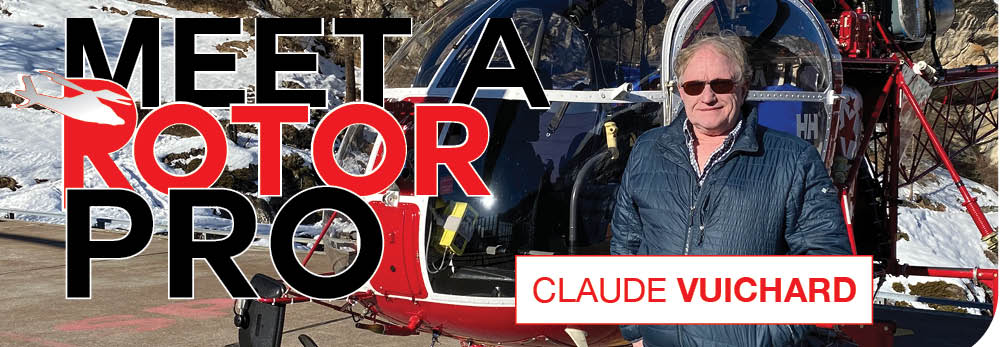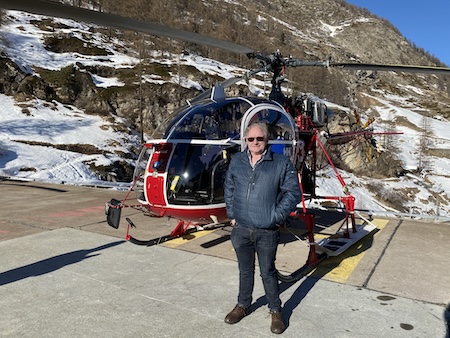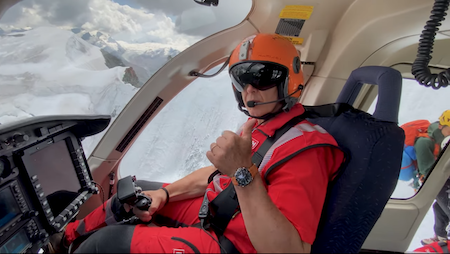|
Nov
25
2024
|
|
Posted 1 years 6 days ago ago by Admin
|
|

RPMN: What is your current position?
I'm the President of the “Vuichard Recovery Aviation Safety Foundation” (VRASF.org). We're a non-profit organization and I'm proud to serve as an international helicopter safety expert, keynote speaker, flight instructor, and producer of new safety videos to improve global helicopter safety. In Switzerland, I also run a small flight school for advanced training, including mountain ratings.
RPMN: Tell me about your first experience with helicopters.
My first helicopter was the Bell 47 G3 in 1980, the so-called "aeronautical mother's milk". I got my PPL and CPL in it and combined it with a SA135 B Lama conversion. These helicopters are completely different in performance, but offer incredible views! Having flown many other types on critical mountain rescue missions, I missed the incredible view I had from my first two types.
RPMN: How did you get your start in the helicopter industry?
After I got my CPL (H), I actually had the problem that I didn’t have any money left to fly and nobody really hires a pilot with 150 hours. Then I tried to take flights with relatives and friends, but that dried up quickly. Afterwards I was able to do ferry flights in Europe and realized immediately that such flights are also very demanding. Then I got my first job for a TV studio with a Bell 206. After that, I joined another company where I was able to build up my experience with a Lama in sling operations. A big step came when I joined Air-Zermatt. There, I also gained experience as a rescue pilot. Back then, we flew rescues at night without night vision goggles, GPS or wind information. That was very demanding.
RPMN: When and how did you choose the helicopter industry? Or did it choose you?
I have been fascinated by helicopters since I was a child. After completing my technical degree, I was thrilled to finally make my childhood dream come true and start my helicopter training!
It was a personal decision to enter the helicopter industry, despite the lack of certainty about what to expect in this profession and the number of critical decisions a helicopter pilot must make on a daily basis.
I was fortunate to have the opportunity to participate in a huge number of remarkable missions, including supply and construction flights and numerous rescue operations in challenging mountainous terrain, such as the Matterhorn.Then I worked for the Swiss government for 25 years. I was also honored to serve as a pilot for Swiss presidents and ministers for 14 years. Additionally, I had the privilege of supporting the Swiss government in over 20 years of SAR operations for overdue aircrafts.

RPMN: If you were not in the helicopter industry, what else would you see yourself doing?
It is a challenging question, particularly given my 44 years of experience in the helicopter industry. I have flown fixed-wing aircraft throughout my career, from mountain landings to being a captain of a business jet. However, I have always remained committed to helicopters.
As a rescue pilot, I had the privilege of directly saving many lives. There are undoubtedly other intriguing roles where one can assist others. I am also drawn to medicine and the latest developments in that field. Additionally, I find the world of photography and film very fascinating.
RPMN: What do you enjoy doing on your days off?
I absolutely love traveling with my partner and our camper van, especially from Switzerland to neighboring countries. We also do a lot of tandem cycling and then drive across all the possible passes through the Alps. Other outdoor activities such as skiing, snowshoeing and hiking are also on the agenda.
Of course, as soon as I hear a helicopter, I look up at the sky and then at a Flightradar app to find out more. Even after such a long time, you are not completely disconnected from the helicopter industry, not even on vacation.
RPMN: What is your greatest career accomplishment to date?
To read this following post: “My hat is off to Mr. Vuichard. Sir, I owe my life to this technique. Thank you, sir, for developing this awesome technique and I want you to know my family and I are greatful that I am still alive”. These moments are very emotional, especially when I have the opportunity to talk to the pilot about the incident, how it happened, and how he saved the lives of everyone on board with the Vuichard recovery technique.
RPMN: Have you ever had an “oh, crap” moment in helicopters? Can you summarize what happened?
Of course, there have been some very critical moments in such a long career. Once I had an engine failure in the initial climb phase, but luckily I was able to perform a saved forced landing and no one was injured. One very tricky situation was when I was returning from a rescue mission at night and suddenly found myself in an IMC due to a heavy snow shower. In the following safety video, you can see in detail how I got out of this dangerous IIMC/UIMC situation.

(https://youtu.be/LId0EeuyF-0?si=U7dysUwJzMfZUnwa)
RPMN: If you could give only one piece of advice to new pilots, mechanics, or support personnel, what would it be?
It is a fact that human errors are the major cause of helicopter accidents. Pilots must address the issue of operational safety constantly. They must learn from the mistakes of others, use all available resources to avoid making the same mistake again so they can pursue this wonderful profession until retirement.
RPMN: In your view, what is the greatest challenge for the helicopter industry at this moment in time?
As a safety expert, I am constantly analyzing helicopter accidents at all levels. Unfortunately, I realize that the entire helicopter industry still has a tremendous amount of work to do to reduce the number of accidents. However, I am very confident that with the introduction of new simulators, especially those with VR technology that are now available for smaller helicopters, combined with evidence-based training, the number of accidents will decrease significantly. It is also important to recognize the many other challenges facing the helicopter industry today: increasing demands by regulators,environmental restrictions, eVTOL, drones, pilot shortages and fuel prices.
READ MORE ROTOR PRO: https://justhelicopters.com/Magazine
WATCH ROTOR PRO YOUTUBE CHANNEL: https://buff.ly/3Md0T3y
You can also find us on
Instagram - https://www.instagram.com/rotorpro1
Facebook - https://www.facebook.com/rotorpro1
Twitter - https://twitter.com/justhelicopters
LinkedIn - https://www.linkedin.com/company/rotorpro1